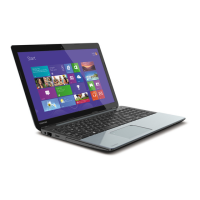
Do you have a question about the Toshiba Satellite S50D-A Series and is the answer not in the manual?
| Operating System | Windows 8.1 |
|---|---|
| Bluetooth | Bluetooth 4.0 |
| Display | 15.6" HD (1366x768) |
| Optical Drive | DVD SuperMulti Drive |
| Wireless | 802.11b/g/n |
| Ports | HDMI, RJ-45, Headphone/Microphone combo port |
| Storage | 1TB HDD |
Manual copyright notice, disclaimer regarding accuracy, and trademark information.
Information regarding FCC compliance, EU Declaration of Conformity, and other regulatory notices.
General safety precautions for computer usage, ventilation, and environment.
Explanation of safety icons used in the manual to convey important information.
Checklist of hardware and documentation included with the computer.
Basic information and steps to start using the computer for the first time.
Instructions for connecting the AC adaptor to power the computer and charge the battery.
Procedure for turning on the computer and initial setup steps.
Methods for shutting down, sleeping, or hibernating the computer.
Description of the computer's front components when the display is closed.
Identification and description of ports and indicators on the left side of the computer.
Identification and description of ports and features on the right side of the computer.
Details about the internal hardware components of the computer.
Instructions on how to use the touch screen for navigation and interaction.
Explanation of touch pad gestures and basic operations for cursor control.
Overview of keyboard layout, keys, and indicators like CAPS LOCK and NUM LOCK.
Information on battery types, usage, recharging methods, and handling precautions.
Description of connecting and disconnecting to a Local Area Network (LAN).
Guidance on connecting and using external monitors via RGB and HDMI ports.
Overview of pre-installed utilities and applications with instructions on how to start them.
Utility for customizing hardware settings and BIOS configuration.
Feature using acceleration sensor to protect the hard disk drive from shocks.
Utility for managing Sleep and Charge, and Sleep and Music functions.
Utility for setting user and supervisor passwords for computer security.
Options and procedures for system recovery and creating recovery media.
Guidelines and steps for diagnosing and resolving computer problems effectively.
Basic checks to perform for common issues before detailed troubleshooting.
Tips for identifying the cause of malfunctions based on system behavior.
Troubleshooting common hardware and system issues and their potential causes.
Information on how to contact TOSHIBA for technical assistance and support.
Summary of the computer's technical specifications and requirements.
Details on wireless technology interoperability, health, and regulatory information.
Notes regarding CPU performance variations and product usage conditions.
Definitions of terms and abbreviations used throughout the manual.









